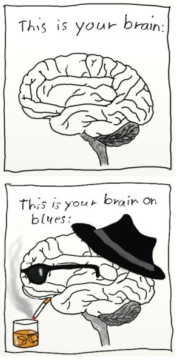by Jochen Szangolies

There are two main problems that bedevil any purported theory of the mind. The first is the Problem of Intentionality: the question of how mental states can come to be about, or refer to, things in the world. The second is the Problem of Phenomenal Experience: the question of how come there is ‘something it is like’ to be in a certain mental state, how mental content is something that appears to us in a certain way (this is also often referred to as simply the ‘Hard Problem’).
These problems are often assumed to be separate issues. However, in a recent article published in the journal Erkenntnis (pre-print version), I propose that one can make progress on the Problem of Intentionality, but at the expense of leaving the Hard Problem unsolvable—indeed, making the task of ‘solving’ it a kind of conceptual confusion: an attempt of capturing the non-structural, non-relational in terms of structure and relation.
In a nutshell, I propose that states of mind are intentional because, through what I call the von Neumann-process, their own properties are represented to themselves; to the extent that these properties then reflect those of objects in the world, the properties of those objects are available to them. Hence, a mental state becomes ‘about’ the world by being, first and foremost, about itself.
The question then arises how self-reference is turned into ‘other-reference’—how to save the mind from being locked into mere self-representational navel-gazing. There, I stipulate that the answer lies in an intriguing property of a certain kind of logic that is concerned with what a given system can formally establish (known as provability logic)—namely, the existence of so-called ‘fixed points’. These allow us to take a self-referential formula and turn it into a formula from which the self-reference has been eliminated—and thus, for a state of mind to interpret itself as referring to a certain state of affairs beyond itself, out there in the world. In particular, it can then be shown that the state of mind producing a certain action aimed at realizing a particular goal is about that goal, representing it to itself.
While this is a nice result, it comes at a price. In general, in deciding whether taking a certain action brings about the desired goal, the von Neumann-process encounters undecidable propositions—that is, questions that cannot be settled by means of any formal procedure (e.g., computation). To overcome this obstacle, mental states must have access to their own properties that goes beyond the theoretical—rather than merely having a theory of themselves, they must have direct access to their own intrinsic properties. It is then this direct access that gives mental states their qualitative nature; and the theory-transcending nature of this access is what makes the Hard Problem unsolvable.
To unpack this, we need to think about the relationship between theory and the world.
Critique Of Theoretical Reason
In the previous column, I used the example of the relationship between an object’s surface and its interior as an analogy for the link between scientific theories and the world they describe. The scientific observer is a node in the web of (causal) relations between whatever things populate the world, and as such, only that web of relations is ever available to scientific investigation, leaving the character of the ‘things themselves’ forever beyond access. Similarly, in a 3D world, only 2D surfaces are directly visible to an observer embedded within the world—we’re only savvy to the ways in which the world connects with us, not to what’s behind those contact surfaces.
Here, I want to introduce a different way of thinking about this connection. Consider the natural numbers—that is, the numbers 1, 2, 3, and so on. With these, we can do all manner of useful things: we can count, we can add and subtract them, figure out into how many slices a cake needs to be sliced so that everyone at the party gets one, and so on. They can evidently be used to model certain properties of things in the world—if Alice has two slices and Bob has three, the fact that 3 is larger than 2 means that Bob ate more cake than Alice.
But what about the properties of the natural numbers themselves? We might, for instance, notice that certain numbers can be written as a product of others—2 x 3 = 6—while others, such as 7, can’t. How many of those indecomposable, ‘prime’ examples of numbers are there?
Clearly, it won’t do to just start looking at the numbers one by one, and see if they can be decomposed. You’d never get done in time for dinner. What we need is a way to talk about the properties of natural numbers in general, abstracted away from each particular number. We need, in other words, a theory of the natural numbers.

In mathematics, ever since the great Euclid wrote his seminal Elements sometime around 300 BCE, such a theory is given by a set of axioms, together with rules of inference that tell us how to derive theorems from them. Axioms are usually thought of as self-evidently true, and the rules of inference preserve truth; consequently, any theorem produced in this manner encapsulates a truth about the theory’s object. (In mathematical logic, this ‘object’ is usually called a ‘model’, but in the present context, such usage would be needlessly confusing.)
For more than 2000 years, mathematicians could take themselves to inhabit a pristine world where all truths about the objects they study flow in a step-by-step procedure of deduction from the appropriate theories. Then, in 1931, the young logician Kurt Gödel with a single stroke shattered two millennia of crystalline certainty, introducing incompleteness, undecidability, and even randomness into the foundations of mathematics.
What Gödel showed was, essentially, that there are truths about the natural numbers as an object that the theory of natural numbers—the axioms and formal deduction rules—could never demonstrate, and that, worse yet, no attempt to complete the theory could ever succeed: the truths about the natural numbers will always outrun those obtainable from any theory.
Mathematicians generally prefer to speak of this the other way around: they say that the theory of natural numbers (and every theory of equivalent or greater power) is incomplete. I find this somewhat unfortunate: it fosters thinking of the phenomenon as a ‘flaw’ in mathematics, as some essential lacuna or defect. But it isn’t really a problem for mathematics, at all—only for mathematicians: the natural numbers care preciously little about our troubles with finding a theory capable of reproducing all true facts about them. Their truths are just true, their properties are the way they are; it’s theory-making that falls short. In a way, the natural numbers (and objects of equivalent complexity) are just too rich in phenomena to be accounted for by any single set of taut mathematical statements.
This perspective also makes another consequence of incompleteness more immediate: as a given set of axioms can’t decide whether the natural numbers have a certain property, it can’t distinguish between an object that has that property, and another that doesn’t—that is, for any theory, we can cook up all manner of objects, each differing from another along certain properties, such that the theory applies equally well to all of them. This is an insight worth emphasizing: a theory on its own doesn’t fix the object it applies to!
Axioms:Object::Theory:World
This is an issue we have already met, in the form of what I’ve called ‘relational underdetermination’ in the previous column (in the philosophical literature often encountered as ‘Newman’s objection’, after the mathematician Max Newman, who raised it against Bertrand Russell’s ‘causal theory’ of perception). The axioms of a mathematical theory only specify a certain relational structure, and this structure fails to be sufficient to pick out a unique object that satisfies it.

A mental image I find helpful is painting by numbers: the axioms provide you with the outline of an object, but this outline can be painted in differently, leading to distinct resulting pictures. In the end, it’s a familiar phenomenon: what was the name of that guy, you know, who was in that movie with the lead singer of that one band which played at the festival together with…? Without ever bottoming out in the familiar, such a daisy-chain of relations fails to uniquely specify its object.
Let’s thus stipulate that there is an analogy here: the axioms of mathematics relate to their objects as our scientific theories relate to the world. It’s worth again quoting Eddington on this matter:
Whenever we state the properties of a body in terms of physical quantities we are imparting knowledge as to the response of various metrical indicators to its presence, and nothing more. After all, knowledge of this kind is fairly comprehensive. A knowledge of the response of all kinds of objects—weighing-machines and other indicators—would determine completely its relation to its environment, leaving only its inner un-get-atable nature undetermined.
If this analogy holds, theories in general are incapable of capturing their objects in full. The truths of the world always outrun any attempt to capture them in the cage of deductive reason—the real nature of objects forever eludes the lobster’s claw.
As argued elsewhere, this leads to a threefold split in the properties of the world. First, there are the decidable structural (or relational) properties, which are those captured by axioms and theories, which we might have thought exhaust all possibilities, before the problems of underdetermination were uncovered. Then, there are the undecidable structural properties, which are those statements that can be formulated within a theory, but which the theory can’t decide (elsewhere called ‘noncomputable properties’).
But finally, and most importantly, there are the properties of the object itself—the relata that fulfill the relations captured by theory. They’re related to our theories as the features of geography are related to a map of the terrain. They are what’s really primary to the world, with the structural properties ultimately just being their ‘epistemic shadow’—the portion of the properties of an object that can feature in our theories of that object. They’re the natural numbers, access to which is mediated through a particular set of axioms. They’re the interior of which we only ever see the surface.
But how does this help us with the problems of the mind? Well, the sort of view outlined so far is close to what’s usually called Russellian monism, after the eminent mathematician and philosopher Bertrand Russell (who, with some measure of irony, together with Alfred North Whitehead originated the mathematical system smashed by Gödel’s proof—meaning that the hammer of structural underdetermination was wielded twice against Russell). It combines two key theses we’ve already encountered, the claim that physical theories are structural in nature, and the claim that there are properties of objects going beyond the structural (sometimes called ‘quiddities’), with a third, namely, that these properties are what is present to us in conscious experience. But there’s a few added wrinkles to consider.
Löb’s Theorem: Or, Can You Really Trust Your Kids?
In the model I’ve been developing, a mental state is given by a particular kind of construction, which is most closely analogous to a self-replicating agent. To self-replicate, it needs access to its own properties; this is achieved by von Neumann’s design, which endows it with self-representational capacities. New states of mind are born—or constructed—from prior states, perhaps in modified form, to take account of the fact that—all indications to the contrary notwithstanding—humans do, occasionally, change their minds.
However, as every parent knows, the decision to procreate is not one to be undertaken lightly. What if your progeny doesn’t turn out the way you hope they will? In the ecosystem of the mind, this might have fatal consequences: suppose a replicator constructs a successor whose goals aren’t well aligned with those beneficial to the agent’s well-being. The result might be catastrophic, potentially leading to the agent’s demise, and thus, the end of its line of procreation—hence, evolutionary pressure ought to shape the replicators sitting in our brains like pilots in the cockpit in such a way as to make sure that its successors share its goals.
But that’s not such an easy task. As pointed out by AI researchers Eliezer Yudkowski and Marcello Herreshoff, in general, a replicator can’t trust that its successor’s conclusions about the world are true, if that successor isn’t less ‘smart’ in a certain sense. Thus, it can’t trust that when the successor has convinced itself that a certain action will help bring about a given goal, then it’s in fact true that the action will help bring the goal about. The reason for this is Löb’s theorem: if a system can prove that all of its proofs yield truths, then it follows that the system is inconsistent. If thus a successor replicator has the same ‘intelligence’ as its parent, then the parent can’t be certain that its reasoning is sound—it can’t trust its copy, because it can’t trust itself. (I won’t try to go into the details of Löb’s theorem; for those who want to dig a little deeper, I suggest checking out the Cartoon Guide to Löb’s Theorem.)
It’s here that the above distinction between structural and non-structural properties, or between theory and object, can be made to do some useful work. The decision of whether to construct a successor—or equivalently, whether to modify itself—is rendered as an undecidable proposition in the Gödelian sense. But undecidability exists on the level of theory: questions about, say, the natural numbers are undecidable because their properties outrun our theoretical access. But that doesn’t mean these properties are themselves in doubt—any given undecidable proposition about the natural numbers is either true, or not. So to the numbers themselves, in a sense, there is no undecidability.
So, if the replicator only had theoretical access to its properties, it would stand helpless before the question of whether to replicate. But in this case, we’re not in a situation where some external agent reasons about an object by means of a theory—the replicator is itself the object of its investigations. Rather than a mathematician thinking about numbers, it’s more like numbers thinking about themselves!

Theories mediate access to objects for external agents—and only ever imperfectly. But the access the replicator has to itself is not theory-mediated: it does not need to derive its own properties from some set of axioms, it only needs to have them. This is because of its self-referential nature: the properties in question are such that having them is equivalent to having access to them.
Moreover, it turns out that, via the fixed-point property of provability logic, the self-referential proposition corresponding to the question of whether to replicate—which, recall, just means any sort of change of mind at all—is equivalent to one encapsulating the goal intended to be brought about by doing so. That is, if I formulate the intention of grabbing the apple before me on the table and taking a hearty bite, my mental state, to facilitate this action—to enable the change of mind, the instance of replication that ultimately causes my muscles to contract in just such-and-such a way—must interpret itself as incorporating that goal—and do so in a way forever beyond theoretical analysis.
This yields a two-pronged result: first of all, it provides the structure of theory with a concrete object to apply to, thus overcoming the underdetermination that structure alone entails. In the end, this is what makes knowledge of the world possible at all: without it, a merely structural account would fail to apply to any one thing in particular, just like the axioms of the theory of the natural numbers fail to single them out uniquely. But moreover, it gives a reason why what is present to us in experience has so cunningly eluded theoretical grasp: because it is itself the non-structural element that gives the structure of theory its concrete content; so to ask for it to be captured by theory in turn amounts to nothing but putting Descartes before the horse.
